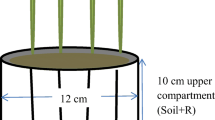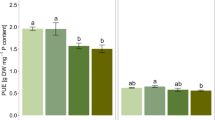Abstract
Background & Aims
Previous studies revealed that cotton plants grown on soils with low available-P were accessing significant non-fertilizer P sources. This suggests that cotton can access stable-P pools from soil. This study examined cotton’s ability to utilize sparingly soluble P sources in comparison with wheat and white lupin.
Methods
Plants were grown for 45 days in a Vertosol supplied with AlPO4 and hydroxyapatite, and NH4-N or NO3-N. A 32P dilution technique was used to determine the availability and plant uptake of P from these P sources.
Results
Three species differed substantially in P acquisition from the P sources. When averaged over N sources, the proportion of P in shoots sourced from AlPO4 was 89%, 54% and 19% for wheat, cotton and white lupin, respectively. When supplied hydroxyapatite, white lupin sourced 75% from the added P, in contrast to 36% for wheat and 17% for cotton. NH4-N nutrition increased the availability of hydroxyapatite to all the species and AlPO4 to cotton and white lupin.
Conclusion
Cotton is inefficient in utilizing sparingly soluble P while wheat is efficient in mobilising AlPO4 and white lupin is efficient in using hydroxyapatite. The superiority of wheat in AlPO4 utilization may be related with its high root length density.



Similar content being viewed by others
References
Ae N, Arihara J, Okada K, Yoshihara T, Johansen C (1990) Uptake mechanism of iron-associated phosphorus in pigeonpea growing on Indian Alfisol and its significance to phosphorus availability in cropping systems. In: 14th International Congress of Soil Science. Kyoto, pp 164–169 (International Society of Soil Science)
Apthorp JN, Hedley MJ, Tillman RW (1987) The effect of nitrogen fertilizer form on the plant availability of phosphate from soil, phosphate rock and mono-calcium phosphate. Fertilizer Res 12:269–284
Armstrong RD, Helyar KR, Prangnell R (1993) Direct assessment of mineral phosphorus availability to tropical crops using 32P labelled compounds. Plant Soil 150:279–287
Bekele T, Cino BJ, Ehlert PAI, van der Maas AA, van Diest A (1983) An evaluation of plant-borne factors promoting the solubilization of alkaline rock phosphates. Plant Soil 75:361–378
Bertrand I, Hinsinger P, Jaillard B, Arvieu JC (1999) Dynamics of phosphorus in the rhizosphere of maize and rape grown on synthetic, phosphated calcite and goethite. Plant Soil 211:111–119
Bolland MDA, Brennan RF (2008) Comparing the phosphorus requirements of wheat, lupin, and canola. Aust J Agric Res 59:983–998
Braum SM, Helmke PA (1995) White lupin utilizes soil phosphorus that is unavailable to soybean. Plant Soil 176:95–100
Cerezine PC, Nahas E, Banzatto DA (1988) Soluble phosphate accumulation by Aspergillus niger from fluorapatite. Appl Microbiol Biotechnol 29:501–505
Colwell JD (1963) The estimation of phosphorus fertilizer requirement of wheat in southern New South Wales by soil analysis. Aust J Exp Agric Anim Husb 3:190–197
Cox FR, Barnes JS (2002) Peanut, corn, and cotton critical levels for phosphorus and potassium on Goldsboro soil. Commun Soil Sci Plant Anal 33:1173–1186
Cox WJ, Reisenauer HM (1973) Growth and ion uptake by wheat supplied nitrogen as nitrate, or ammonium or both. Plant Soil 38:363–380
Crozier CR, Walls B, Hardy DH, Barnes JS (2004) Response of cotton to P and K soil fertility gradients in North Carolina. J Cotton Sci 8:130–141
Cumming JR, Weinstein LH (1990) Utilization of AlPO4 as a phosphorus source by ectomycorrhizal Pinus rigida Mill. seedlings. New Phytol 116:99–106
Di HJ, Cameron KC (2004) Effects of temperature and application rate of a nitrification inhibitor, dicyandiamide (DCD), on nitrification rate and microbial biomass in a grazed pasture soil. Aust J Soil Res 42:927–932
Dinkelaker B, Römheld V, Marschner H (1989) Citric acid excretion and precipitation of calcium citrate in the rhizosphere of white lupin (Lupinus albus L.). Plant Cell Environ 12:285–292
Dorahy CG, Rochester IJ, Blair GJ (2004) Response of field-grown cotton (Gossypium hirsutum L.) to phosphorus fertilisation on alkaline soils in eastern Australia. Aust J Soil Res 42:913–920
Dorahy CG, Blair GJ, Rochester IJ, Till AR (2007) Availability of P from 32P-labelled endogenous soil P and 33P-labelled fertilizer in an alkaline soil producing cotton in Australia. Soil Use Manage 23:192–199
Dorahy CG, Rochester IJ, Blair GJ, Till AR (2008) Phosphorus use-efficiency by cotton grown in an alkaline soil as determined using 32phosphorus and 33phosphorus radio-isotopes. J Plant Nutr 31:1877–1888
Gahoonia TS, Nielsen NE (1992) The effect of root induced pH changes on the depletion of inorganic and organic phosphorus in the rhizosphere. Plant Soil 143:185–191
Gahoonia TS, Claassen N, Jungk A (1992) Mobilization of phosphate in different soils by ryegrass supplied with ammonium or nitrate. Plant Soil 140:241–248
Guppy CN, Menzies NW, Moody PW, Compton BL, Blamey FPC (2000) A simplified sequential phosphorus fractionation method. Commun Soil Sci Plant Anal 31:1981–1991
Hibberd DE, Ladewig JH, Hunter MN, Blight GW (1990) Responses in cotton yields to nitrogen and phosphorus fertilisers in the Emerald Irrigation Area, central Queensland. Aust J Exp Agr 30:661–667
Hinsinger P, Gilkes RJ (1995) Root-induced dissolution of phosphate rock in the rhizosphere of lupins grown in alkaline soil. Aust J Soil Res 33:477–489
Hinsinger P, Gilkes RJ (1996) Mobilization of phosphate from phosphate rock and alumna-sorbed phosphate by the roots of ryegrass and clover as related to rhizosphere pH. Eur J Soil Sci 47:533–544
Hinsinger P, Plassard C, Tang C, Jaillard B (2003) Origins of root mediated pH changes in the rhizosphere and their responses to environmental constraints: a review. Plant Soil 248:43–59
Isbell RF (2002) The Australian soil classification (revised edition). CSIRO Publishing, Collingwood
Khasawneh FE, Doll EC (1978) The use of phosphate rock for direct application to soils. Adv Agron 30:159–206
Kirk GJD, Santos EE, Santos MB (1999) Phosphate solubilization by organic anion excretion from rice growing in aerobic soil: rates of excretion and decomposition, effects on rhizosphere pH and effects on phosphate solubility and uptake. New Phytol 142:185–200
Lambers H, Juniper D, Cawthray G, Veneklaas EJ, Martinez-Ferri E (2002) The pattern of carboxylate exudation in Banksia grandis (Proteaceae) is affected by the form of phosphate added to the soil. Plant Soil 238:111–122
Li H, Shen J, Zhang F, Tang C, Lambers H (2008) Is there a critical level of shoot phosphorus concentration for cluster-root formation in Lupinus albus? Funct Plant Biol 35:328–336
Lindsay WL, Fraser AW, Stephenson HF (1962) Identification of reaction products from phosphate fertilisers in soils. Soil Sci Soc Am J 26:446–452
Lindsay WL, Vlek PLG, Chien SH (1989) Phosphate minerals. In: Dixon JB, Weed SB (eds) Minerals in soil environment, 2nd edn. Soil Sci Soc Am, Madison, pp 1089–1130
Morel C, Fardeau JC (1989) Native soil and fresh fertilizer uptake as affected by rate of application and P fertilizers. Plant Soil 115:123–128
Morel C, Fardeau JC (1990) Uptake of phosphate from soils and fertilizers as affected by soil P availability and solubility of phosphorus fertilizers. Plant Soil 121:217–224
Motomizu S, Wakimoto T, Toei K (1980) Spectrophotometric determination of phosphate in river waters with molybdate and malachite green. Analyst 108:361–367
Neumann G, Römheld V (1999) Root excretion of carboxylic acids and protons in phosphorus deficient plants. Plant Soil 211:121–130
Nuruzzaman M, Lambers H, Bolland MDA, Veneklaas EJ (2005) Phosphorus benefits of different grain legume crops to subsequent wheat grown in different soils of Western Australia. Plant Soil 271:175–187
Olsen SR, Dean LA (1965) Phosphorus. In: Black CA (ed) Methods of soil analysis, vol 2. Agron. Monogr. No. 9. Am. Soc. Agron, Madison, pp 1044–1047
Pearse SJ, Veneklaas EJ, Cawthray GR, Barber MDA, Lambers H (2006) Triticum aestivum shows a greater biomass response to a supply of aluminium phosphate than Lupinus albus, despite releasing less carboxylates into the rhizosphere. New Phytol 169:515–524
Pearse SJ, Veneklaas EJ, Cawthray G, Bolland MDA, Lambers H (2007) Carboxylate composition of root exudates does not relate consistently to a crop species’ ability to use phosphorus from aluminium, iron or calcium phosphate sources. New Phytol 173:181–190
Rashid A, Awan ZI, Ryan J (2005) Diagnosing phosphorus deficiency in spring wheat by plant analysis: proposed critical concentration ranges. Commun Soil Sci Plant Anal 36:609–622
Raven JA, Franco AA, de Jesus EL, Jacob-Neto J (1990) H+ extrusion and organic-acid synthesis in N2-fixing symbioses involving vascular plants. New Phytol 114:369–389
Rayar AJ, Hai TV (1977) Effect of ammonium on uptake of phosphorus, potassium, calcium and magnesium by intact soybean plants. Plant Soil 48:81–87
Rayment GE, Higginson FR (1992) Australian laboratory handbook of soil and water chemical methods. Inkata Press, Melbourne
Reuter DJ, Dyson CB, Elliot DE, Lewis DC, Rudd CL (1995) An appraisal of soil phosphorus testing data for crops and pastures in South Australia. Aust J Exp Agr 35:979–995
Sangakkara UR, Cho CM (1987) Effect of NH +4 nitrogen on phosphorus uptake by canola, lentils, soybeans and wheat. J Agron Crop Sci 159:199–201
Sas L, Tang C, Rengel Z (2001) Excess cation uptake, and extrusion of proton and organic acid anion by Lupinus albus under phosphorus deficiency. Plant Sci 160:1191–1198
Shane MW, Lambers H, Cawthray GR (2008) Impact of phosphorus mineral source (Al-P or Fe-P) and pH on cluster-root formation and carboxylate exudation in Lupinus albus L. Plant Soil 304:169–178
Tang C, Drevon JJ, Jaillard B, Souche G, Hinsinger P (2004) Proton release of two genotypes of bean (Phaseolus vulgaris L.) as affected by N nutrition and P deficiency. Plant Soil 260:59–68
Tang C, Conyers MK, Nuruzzaman M, Poile GJ, Liu DL (2011) Biological amelioration of subsoil acidity through managing nitrate uptake by wheat crops. Plant Soil 338:383–397
Thomson CJ, Marschner H, Römheld V (1993) Effect of nitrogen fertilizer form on pH of the bulk soil and rhizosphere, and on the growth, phosphorus and micronutrient uptake of bean. J Plant Nutr 16:493–506
Tisdale SL, Nelson WL, Beaton JD (1985) Soil fertility and fertilizers, 4th edn. Macmillan Publishing Co, New York
Troelstra SR, Van Dijk K, Blacquiere T (1985) Effect of N source on proton excretion, ionic balance and growth of Alnus glutinosa (L.) Gaertner: comparison of N2 fixation with single and mixed sources of NO3 and NH4. Plant Soil 84:361–385
van Ray B, van Diest A (1979) Utilization of phosphate from different sources by six plant species. Plant Soil 51:577–589
Veneklaas EJ, Stevens T, Cawthray GR, Turner NC, Grigg AM, Lambers H (2003) Chickpea and white lupin rhizosphere carboxylates vary with soil properties and enhance phosphorus uptake. Plant Soil 248:187–197
Vu DT, Armstrong RD, Sale PWG, Tang C (2010) Phosphorus availability for three crop species as a function of soil type and fertilizer history. Plant Soil 337:497–510
Wang X (2010) Phosphorus acquisition characteristics of cotton (Gossypium hirsutum L.) compared with other crop species. PhD Thesis, La Trobe Univeristy, Melbourne, Australia
Wang X, Tang C, Guppy CN, Sale PWG (2008) Phosphorus acquisition characteristics of cotton (Gossypium hirsutum L.), wheat (Triticum aestivum L.) and white lupin (Lupinus albus L.) under P deficient conditions. Plant Soil 312:117–128
Wang X, Tang C, Guppy CN, Sale PWG (2010) Cotton, wheat and white lupin differ in phosphorus acquisition from sparingly soluble P sources. Environ Exp Bot 69:267–272
Whitelaw MA, Harden TJ, Helyar KR (1999) Phosphate solubilisation in solution culture by the soil fungus Penicillium radicum. Soil Biol Biochem 31:655–665
Zapata F, Axmann H (1995) 32P isotopic techniques for evaluating the agronomic effectiveness of rock phosphate materials. Fertilizer Res 41:189–195
Zoysa AKN, Loganathan P, Hedley MJ (1998) Effect of forms of nitrogen supply on mobilisation of phosphorus from a phosphate rock and acidification in the rhizosphere of tea. Aust J Soil Res 36:373–387
Acknowledgements
We gratefully acknowledge the financial support from La Trobe University and Cotton Research and Development Corporation. CT was also supported by the Australian Research Council (DP1093650).
Author information
Authors and Affiliations
Corresponding author
Additional information
Responsible Editor: Hans Lambers.
Rights and permissions
About this article
Cite this article
Wang, X., Guppy, C.N., Watson, L. et al. Availability of sparingly soluble phosphorus sources to cotton (Gossypium hirsutum L.), wheat (Triticum aestivum L.) and white lupin (Lupinus albus L.) with different forms of nitrogen as evaluated by a 32P isotopic dilution technique. Plant Soil 348, 85–98 (2011). https://doi.org/10.1007/s11104-011-0901-0
Received:
Accepted:
Published:
Issue Date:
DOI: https://doi.org/10.1007/s11104-011-0901-0




